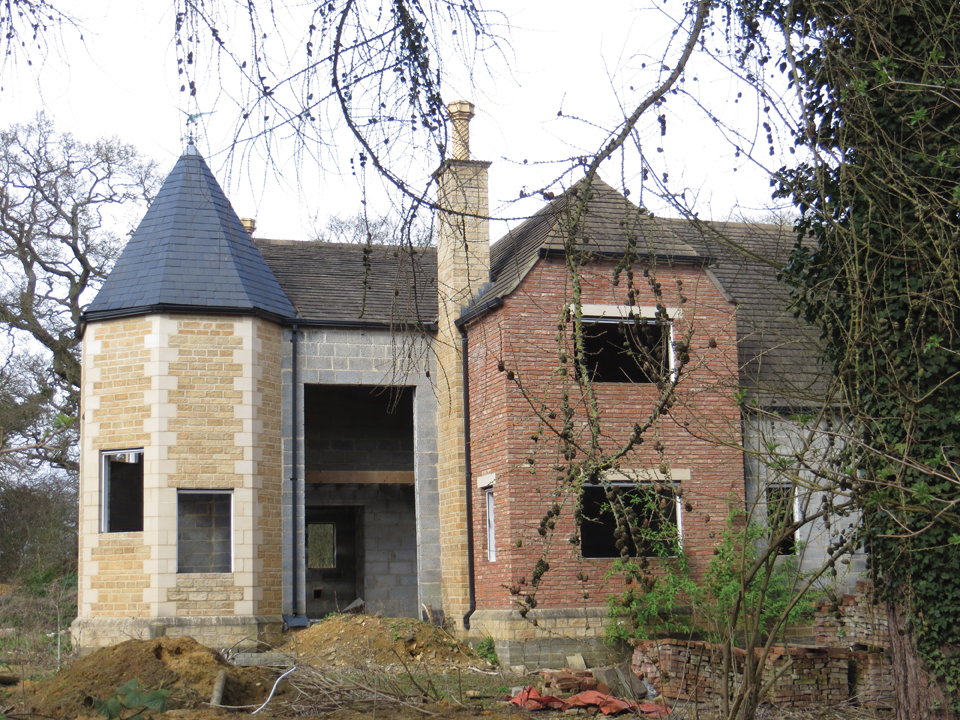Stone in housing: Builders return to work as guidlines become clearer
The government said it would create the conditions to build 300,000 new homes a year. That has not been achieved but the demand that made it desirable is not likely to disappear any more than the growing appreciation of stone is likely to dissipate.
None of us has experienced anything quite like the coronavirus shutdown before, so none of us can be sure how it will be resolved. Some take heart from the fact that Italy manages to shut down every year for a month in August without apparently suffering too much disruption.
Housebuilding and RMI (repair, maintenance & improvement) is only one part of the construction industry, of course, but it tends to be a good indicator of the health of the economy and is significant for much of the stone industry.
So when building sites close, as many have in response to the pandemic, it hurts. It did not happen all at once, but gradually more sites closed as the shutdown went on because the industry believed that was what the government wanted.
Although the guidelines say it is acceptable to leave home to go to work if you cannot work at home, the message was confused by the government referring to ‘essential’ work. Some subbies on their way to sites were reportedly given spot fines by the police for going to non-essential work.
Taylor Wimpey, Vistry, Barratt, Countryside, Crest Nicholson, Redrow, MJ Gleeson and many other builders closed sites and either furloughed employees or said they intend to.
Those that stayed open suffered some pretty heavy trolling on social media, so much so that Build UK members, led by Mace CEO Mark Reynolds, pleaded with the government to designate construction as essential work in order to reassure everyone that those involved had ‘permission’ to leave their homes to go to work.
 It hasn’t. However, since Alok Sharma, Secretary of State at the Department for Business, Energy & Industrial Strategy, wrote an open letter to the construction industry on 31 March making it clear construction sites could stay open and praising those that continued to work, which he said was in line with the Chief Medical Officer’s advice, the message coming from government has been clearer and companies have started to re-open sites. The Scottish parliament has unequivocally closed construction sites, but elsewhere building work is starting up again.
It hasn’t. However, since Alok Sharma, Secretary of State at the Department for Business, Energy & Industrial Strategy, wrote an open letter to the construction industry on 31 March making it clear construction sites could stay open and praising those that continued to work, which he said was in line with the Chief Medical Officer’s advice, the message coming from government has been clearer and companies have started to re-open sites. The Scottish parliament has unequivocally closed construction sites, but elsewhere building work is starting up again.
Housebuilders Taylor Wimpey and Vistry (the firm with a turnover of £1.1billion created from the merger of Galliford Try’s housing business with Bovis Homes at the start of the year) have announced they will be re-opening their sites.
Taylor Wimpey said it would resume work this month (May) while Vestry said it would start re-opening sites from 27 April. Persimmon also said it would be returning to work from 27 April and Bouygues UK is re-opening its English sites, which include some large housing projects.
In response, UK brickmaker Michelmersh is taking its five brickworks out of mothballs and the announcement that it intended to do so was rapidly followed by the same message from Ibstock Brick.
By now there will probably have been further such announcements, made after this issue of Natural Stone Specialist had gone to press in April.
As the builders started to returned to work (outside of Scotland) Robert Jenrick, the Secretary of State for Housing, made a statement on 23 April saying he hoped more builders would follow suit.
“I welcome developers re-opening sites following careful consideration of public health guidance,” he said. “Building the homes the country needs is vitally important. Work in construction can and should continue.
“I hope to see further housebuilders re-open shortly – once they’ve also worked through how to meet social distancing guidelines and protect their workforce.”
How to work safely on site is set out in the Site Operating Procedures from the Construction Leadership Council, the latest version of which was published on 15 April, which the government has accepted as the standard to which the industry must work.
Nevertheless, the shutdown hiatus has certainly taking its toll on housing projects. According to Savills, the estate agent, schemes delivering 193,000 homes came to a halt in the wake of Covid-19 – that’s 80% of housebuilding.
The proportion of those using stone for walls is relatively small, but in those parts of the country with a tradition of stone housebuilding it often is an important part of the business for quarries, especially as many of those areas are wealthy and the houses being built are large and expensive and using a lot of stone.
Wealthier people suffer least from unexpected disruptions to economic activity and a straw poll of quarries that sell walling stone suggests that, while some (although not all) say they have been hit by a fall in sales, and some have shut down temporarily, others have not.
As a sector, British stone does not seem to have been as badly hit as the brickmakers, for example. The fact that many stone companies are relatively small enterprises supplying a handful of projects at a time has meant that if those projects continued, demand was maintained.
For companies supplying natural and engineered stone for interiors, especially worktops, the impact has been greater.
Many fabricators have spent a lot on new factories and machinery in the past few years. The number of worktops needed to pay for the financing of the investments seemed almost immaterial when the investment was made. Now it does not.
The only saving grace is that while interest rates were low when the investments were made, they are now even lower, as long as they are not on a fixed rate, with the Bank of England cutting base rates to 0.1% on 19 March. Even so, with orders drying up even the few worktops needed to cover the repayments are proving hard to sell.
The reason for that is not just because customers are worried about the cost of a new kitchen when their own income might be uncertain, but also because they do not know if they are allowed to have people in their homes to do the work. Even if they are allowed to, they are not sure they want people coming in.
The Site Operating Procedures published by the Construction Leadership Council on 15 April include instructions for working in customers’ homes. It basically says keep your distance, wash or sanitise your hands frequently, and do not work in vulnerable people’s homes unless it is an emergency.
This latest Site Operating Procedures was the third version of this document. The first version was in response to the shutdown, then it was updated with a second version that was rapidly withdrawn because it insisted on procedures such as operatives staying 2m apart, which would have made work on most building sites impossible. The third version incorporates the Public Health England advice on working on construction sites, which involves keeping 2m apart ‘as much as possible’.
There is information on a hierarchy of controls that says if people cannot keep 2m apart they should wear masks to avoid infecting anyone else in case they have the virus. They are also told to wash their hands frequently, especially after handling anything anyone else touches.
The document says that wherever you are working outside of your own home, under no circumstances go to work if you or anyone in your household feels ill or has any symptoms that might be Covid-19.
The guidelines could remain relevant and in force until a vaccine or cure is found for coronavirus, although even that is moving quickly with reports of a team from Oxford University starting to test a vaccine on human volunteers.
Just as the reality of a rapid rise in the number of deaths from the coronavirus gradually closed sites in the days after the Prime Minister’s broadcast announcing the shutdown on 23 March, so the re-opening of sites is happening tentatively. It might even be slowed by the 17 April announcement that lockdown measures would continue for at least another three weeks.
Clearly a lot of housebuilding has been curtailed. The number of potential purchases also took a nose dive. Even sales that had been agreed fell through at an unprecedented rate. According to online estate agent Zoopla, 60% more offers on houses were withdrawn in the week ending 22 March than a week earlier. It said demand for property had fallen 40% in that week.
However, to put that into perspective, the Conservative victory in December’s General Election sparked a surge of demand that has been dubbed the ‘Boris Bounce’. The increase in demand resulted in a sharp rise in house prices that would have been expected to result in more building.
According to the Office for National Statistics, UK average house prices increased by 1.1% over the year to February and by 1.5% in the year to January.
Average house prices increased over the year in England to £246,000 (+0.8%), in Wales to £164,000 (+3.4%), Scotland to £151,000 (+2.5%) and Northern Ireland to £140,000 (+2.5%).
Taylor Wimpey, which is one of the UK’s largest housebuilders, announced at the beginning of this year that its forward order book was up by 22% in value terms and 17% in unit terms. Property developer Galliard also announced sales enquiries were up by 26%.
Then came Covid-19, although the first signs that the effect on the demand for housing might already be waning came from Twenty7Tec, the mortgage industry technology provider, as early as 16 April. It reported that the number of online searches for mortgages to buy (rather than re-mortgage) had seen some improvement for the first time in a month.
The trend continued for the next three days, although for the whole week ending with Saturday 18 April the volume of mortgage searches was down slightly on the week before, down 28% on two weeks earlier and down 56% on four weeks earlier. The value of loans actually agreed in the week was up 25% on the week before, but that was 35% less than two weeks earlier and 60% less than four weeks earlier.
Later in April, James Tucker, CEO at Twenty7Tec, was pleased to see building projects re-opening. So far most are new builds, but, said James: “Hopefully, we can begin to manage a safe return across the whole range of the market from housebuilders to estate agents and mortgage providers to removals companies.” It is a sentiment shared by many stone companies and worktop fabricators.
Source: Office for National Statistics (England) / Source: Central Statistical Office Ireland



